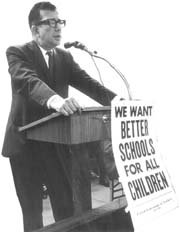Where Al Shanker Stood: Democracy In Public Education
There is an ongoing debate in the U.S. about the role of democracy in public education. In March 1997, in his final “Where We Stand” column in the New York Times, Al Shanker addressed this issue directly. The piece, published posthumously, was an excerpt from a larger essay entitled “40 Years in the Profession,” which was included in acollection published by the Phi Delta Kappa Educational Foundation.
Why do I continue when so much of what I’ve worked for seems threatened? To a large extent, because I believe that public education is the glue that has held this country together. Critics now say that the common school never really existed, that it’s time to abandon this ideal in favor of schools that are designed to appeal to groups based on ethnicity, race, religion, class, or common interests of various kinds. But schools like these would foster divisions in our society; they would be like setting a time bomb.
A Martian who happened to be visiting Earth soon after the United States was founded would not have given this country much chance of surviving. He would have predicted that this new nation, whose inhabitants were of different races, who spoke different languages, and who followed different religions, wouldn’t remain one nation for long. They would end up fighting and killing each other. Then, what was left of each group would set up its own country, just as has happened many other times and in many other places. But that didn’t happen. Instead, we became a wealthy and powerful nation—the freest the world has ever known. Millions of people from around the world have risked their lives to come here, and they continue to do so today.
Public schools played a big role in holding our nation together. They brought together children of different races, Shanker Blog » Where Al Shanker Stood: Democracy In Public Education:

